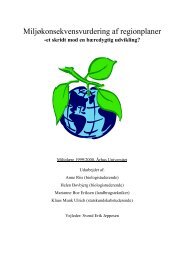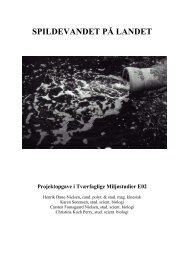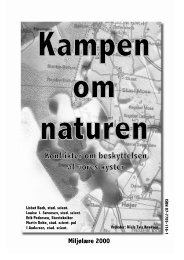University of Aarhus ECOTOURISM AS A WAY TO PROTECT ...
University of Aarhus ECOTOURISM AS A WAY TO PROTECT ...
University of Aarhus ECOTOURISM AS A WAY TO PROTECT ...
Create successful ePaper yourself
Turn your PDF publications into a flip-book with our unique Google optimized e-Paper software.
Ecotourism as a sustainable way to protect nature<br />
hostile environment <strong>of</strong> the islands. Relatively few plants succeed in doing this,<br />
so Galapagos Islands have far fewer species than in similar environments on the<br />
South American mainland.<br />
The plants have few specialised fleshy fruits and showy flowers, because<br />
they have adapted to very few insects and other pollinators to pollinate their<br />
flowers and disperse their fruits.<br />
The Galapagos Islands have 560 native species and one third <strong>of</strong> these are<br />
endemic, species such as cotton, tomato, pepper, guava and passionflower.<br />
Introduced species is a big problem on the Galapagos. They arrived with<br />
the people for the purposes <strong>of</strong> either agriculture or gardening. Now they have<br />
become pests and invade the native vegetation. In 1999, 475 introduced species<br />
where known, and 10 new species arrive each year. In 2007, it is estimated that<br />
the introduced species will outnumber the native ones (Galapagos Conservation<br />
Trust, 2002).<br />
Introduced animals are also a big problem. Goats, donkeys and cattle have<br />
decimated the vegetation, and introduced insects and other invertebrates have<br />
infected and killed many native species (Galapagos Conservation Trust, 2002).<br />
b. Fauna<br />
Galapagos has many unique and endemic animals, most <strong>of</strong> which are<br />
fearless due to the lack <strong>of</strong> natural predators. One <strong>of</strong> the best known is the giant<br />
tortoise. Scientist believes the tortoises have drifted from the mainland with the<br />
ocean current, their shells keeping them afloat, and that the giant tortoise has<br />
grown to an immense size (250 kg), because <strong>of</strong> abundant food and absence <strong>of</strong><br />
predators (Galapagos Conservation Trust, 2002).<br />
There have been 14 races <strong>of</strong> tortoises, evolved on 14 different islands, but<br />
as a result <strong>of</strong> hunting, 3 races are extinct and 1 left <strong>of</strong> the fourth race. It is<br />
41
















